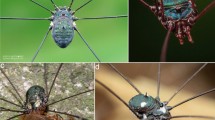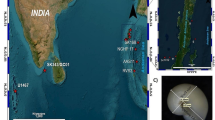Abstract
Densely packed granular inclusions composed of opal filaments were observed in two types of cells in the ascidian Styela clava. Herdman, 1881: oocyte test cells and cells of the interstitial ovarian tissue. Cytochemical analysis, scanning electron microscopy, transmission electron microscopy and microanalysis were used to study the cytology of the ovarian cells. The inclusions consist of intracellular filaments in which silica is bound to proteins. The role of this silica accumulation, very uncommon in invertebrates, is unknown. However, the silica granules are obviously closely related to the acid mucopolysaccharides in which they are embedded. Deposition of silica is linked to the seasonal reproductive cycle, and forms in the interstitial tissue and in the maturing oocytes successively. A taxonomic significance of the silica granules is suggested.
Similar content being viewed by others
Literature cited
Botte, L., Scippa, S., Vicentiis, M. de (1979). Content and ultrastructural localization of transitional metals in ascidian ovary. Dev. Growth Differentiation 21: 483–491
Bruening, R. C., Oltz, E. M., Furukawa, J., Nakanishi, K., Kustin, K. (1986). Isolation of tunichrome B-1, a reducing blood pigment of the sea squirt Ascidia nigra. J. nat. Products (Lloydia) 49: 193–204
Cloney, R. (1990). Larval tunic and the function of the test cells in ascidians. Acta Zool. 71: 151–159
Cloney, R., Cavey, M. J. (1982). Ascidian larval tunic. Extraembryonic structures influence morphogenesis. Cell Tissue Res. 222: 547–562
Fröhlich, F. (1989). Deep sea biogenic silica: new structural and analytical data from infrared analysis — geological implications. Terra nova 1: 267–273. (Blackwell Scientific Publications, Oxford)
Gerzeli, G. (1962). Istochimica delle cellule folliculari e delle cellule testali in diverse ascidiacee. Rc. Ist. lomb Sci. Lett. (B: Sci. biol. med.) 96: 165–178
Gianguzza, M., Dolcemascolo, G. (1982). Cytochemistry of the test cells of Ascidia malaca oocytes during vitellogenesis. Archs Biol., Bruxelles 93: 369–379
Guraya, S. S. (1972). Histochemical observations on the developing oocyte of the tunicate, Herdmania. Acta morph. neerl.-scand. 1972: 359–370
Kastner, M., Keene, J. B., Gieskes J. M. (1977). Diagenesis of siliceous oozes. I. Chemical controls on the rate of opal-A to opal-CT transformation — an experimental study. Geochim. Cosmochim. Acta 41: 1041–1059
Kessel, R. G. (1962). Fine structure of pigment inclusions in the test cells of the ovary of Styela. J. Cell Biol. 12: 637–640
Kessel, R. G., Kemp, N. E. (1962). An electron microscopy study on the oocyte, test cells and follicular envelope of the tunicate Molgula manhattensis. J. Ultrastruct. Res. 6: 57–76
Kupffer, C. (1870). Die Stammverwandtschaft zwischen Ascidien und Wirbelthieren. Zap. imp. Akad. Nauk 7: 115–172
Lambert, G., Lambert, C. C., Lowenstam, H. A. (1990). Protochordate biomineralization. In: Carter, J. G. (ed.) Skeletal biomineralization: patterns, processes and evolutionary trends. Van Nostrand Reinhold, New York, p. 461–469
Lowenstam, H. A. (1971). Opal precipitation by marine gastropods (Mollusca). Science, N. Y. 171: 487–490
Lowenstam, H. A., Rossman, G. R. (1975). Amorphous hydrous, ferric phosphatic dermal granules in Molpadia (Holuthuroidea): physical and chemical characterization and ecologic implications of the bioinorganic fraction. Chem. Geol. 15: 15–51
Mancuso, V. (1965). An electron microscope study of the test cells and follicle cells of Ciona intestinalis during oogenesis. Acta Embryol. Morph. exp. (Ser. 1) 8: 239–266
Mansucto, C., Villa (1982). The test cells of Ciona intestinalis and Ascidia malaca during embryonic development. Acta Embryol. Morph. exp. (New Ser. 2) 3: 107–116
Materazzi, G., Vitaioli, L. (1969). Further cytochemical studies of the mucopolysaccharides of the test cells of Ciona intestinalis L. Histochemie 19: 58–63
Monniot, F. (1970). Les spicules chez les tuniciers aplousobranches. Archs Zool. exp. gén. 111: 303–312
Mukai, H., Watanabe, H. (1978). Studies on some aspects of ovulation and embryogenesis in the compound ascidian Botryllus primigenus. Annotnes zool. jap. 51: 211–221
Pascal, P. (1965). Système silice-eau. Etats ioniques et dispersés. In: Pascal, P. (ed.) Nouveau traité de chimie minérale. VIII. Masson, Paris, p. 447–502
Pearse, A. G. E. (1968) Histochemistry, theoretical and applied. Churchill, London
Pruvot-Fol, A. (1951). Origine de la tunique des tuniciers. Revue suisse Zool. 58: 605–630
Scurfield, G., Anderson, C. A., Segnit, E. R. (1974) Silica in woody stems. Aust. J. Bot 22: 211–230
Seeliger, O. (1893) Tunicata, Bronn's Kl. Ordn. Tierreichs 3 (Suppl. 1): 1–1773
Seshachar, B. R., Rao, S. R. V. (1963). Cytochemistry of the test cells in the eggs of Pyura squamulosa (Tunicata, Pleurogonia). Q. Jl microsc. Sci. 104: 459–464
Simkiss, K., Wilbur, K. M. (1989). Biomineralization. Academic Press, London, San Diego
Simpson, T. L., Volcani, B. E. (1981). Silicon and siliceous structures in biological systems. Springer-Verlag, New York
Sollas, I. (1907) The molluscan radula: its chemical composition and some points in its development. Q. Jl microsc. Sci. 51: 115–136
Van Beneden, E., Julin, C. (1887). Recherches sur la morphologie des tuniciers. Archs Biol., Paris 6: 237–476
Vicentiis, M., Materazzi, G. (1964). Cytochemical research on the mucopolysaccharides of the testaceous cells of the oocytes of Ciona intestinalis L. during the course of oogenesis. Riv. Biol. 57:316–325
Vitaioli, L., Materazzi, G. (1972). Comparative cytochemical studies of the test cells of several Ascidiacea. Riv. Biol. 65: 145–151
Vovelle, J., Grasset, M. (1981). Sequences de la biomineralisation et du tannage dans la radula de Patina pellucida (Linné), prosobranche, Patellidae. Haliotis 11:229–240
Werner, D. (1977).Silicate metabolism. Bot. Monogr. 13: 110–149
Author information
Authors and Affiliations
Additional information
Communicated by J. M. Pérès, Marseille
Rights and permissions
About this article
Cite this article
Monniot, F., Martoja, R., Truchet, M. et al. Opal in ascidians: a curious bioaccumulation in the ovary. Mar. Biol. 112, 283–292 (1992). https://doi.org/10.1007/BF00702473
Accepted:
Published:
Issue Date:
DOI: https://doi.org/10.1007/BF00702473




